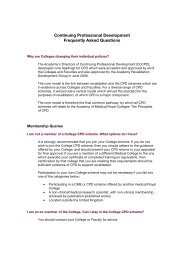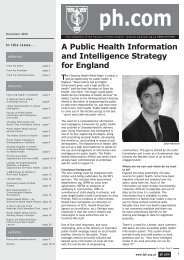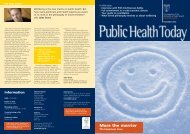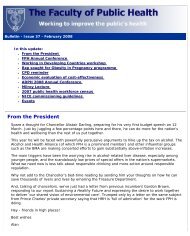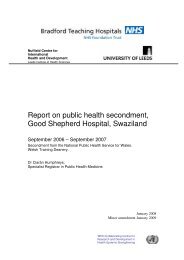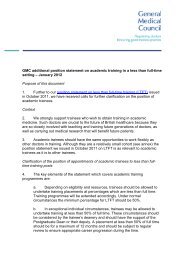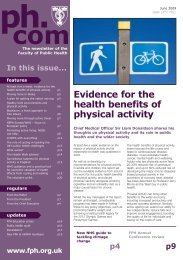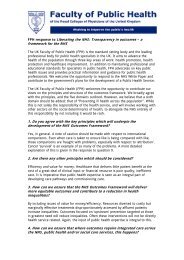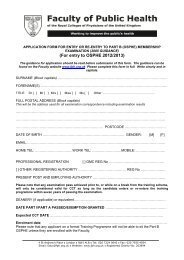A Chronology of State Medicine, Public Health, Welfare and Related ...
A Chronology of State Medicine, Public Health, Welfare and Related ...
A Chronology of State Medicine, Public Health, Welfare and Related ...
You also want an ePaper? Increase the reach of your titles
YUMPU automatically turns print PDFs into web optimized ePapers that Google loves.
Reports <strong>of</strong> the Select Committee on Poor Law Medical Relief (chairman, Lord Ashley)<br />
outlined a comprehensive picture <strong>of</strong> current practice; opposed the requirement for a relieving<br />
<strong>of</strong>ficer to determine need <strong>and</strong> eligibility for medical attention; <strong>and</strong> favoured direct access to a<br />
medical <strong>of</strong>ficer. No change followed the report. See 1861.<br />
1844 Cont - 1846<br />
1844 cont The <strong>Health</strong> <strong>of</strong> the Towns Association established (11 December) for the purpose<br />
<strong>of</strong> diffusing among the people the information obtained by recent inquiries as to the physical<br />
<strong>and</strong> moral evils arising from existing insanitary conditions <strong>and</strong> to “substitute health for<br />
disease, cleanliness for filth, order for disorder, economy for waste, prevention for palliation,<br />
justice for charity, enlightened self-interest for ignorant selfishness <strong>and</strong> to bring to the poorest<br />
<strong>and</strong> meanest – Air, Water, Light”.<br />
Ragged School Union <strong>and</strong> London School Mission formed to provide schooling for<br />
those unable to pay the “school pence” dem<strong>and</strong>ed by voluntary schools. See 1861.<br />
Turnpike Trusts numbered about 1000, <strong>and</strong> were receiving about £1.5 million in tolls<br />
p.a.<br />
Royal College <strong>of</strong> Veterinary Surgeons formed.<br />
“On the Value <strong>of</strong> Numerical Methods as applied to Science, but especially to<br />
Physiology <strong>and</strong> <strong>Medicine</strong>”, <strong>and</strong> “Principles <strong>of</strong> Forensic <strong>Medicine</strong>”, by WA Guy (see 1838),<br />
published.<br />
1845 Lunatics (Care <strong>and</strong> Treatment) Act (8&9 Vict., c.100) <strong>and</strong> Regulation <strong>of</strong> Asylums Act<br />
(8&9 Vict., c.126) improved the procedure for certification; <strong>and</strong> set up a Board <strong>of</strong><br />
Commissioners (chairman, Lord Ashley) to inspect <strong>and</strong> supervise asylums <strong>and</strong> other places<br />
where mentally ill people were cared for. See 1853.<br />
Poor Law Scotl<strong>and</strong> (Amendment) Act (8&9 Vict., c.83) followed the report published<br />
in 1843 <strong>of</strong> the Commission on Poor Relief in Scotl<strong>and</strong>; established the Board <strong>of</strong> Supervision<br />
<strong>of</strong> the Poor in Scotl<strong>and</strong>; retained the parish as the unit <strong>of</strong> administration with parochial boards<br />
consisting <strong>of</strong> elected representatives <strong>and</strong>, ex <strong>of</strong>ficio, the chief magistrate as the manager.<br />
Each board had to appoint an inspector <strong>of</strong> the poor who had direct control <strong>of</strong> relief <strong>and</strong> could<br />
only be dismissed by the Board <strong>of</strong> Supervision. Relief was limited to the aged <strong>and</strong> infirm<br />
poor. Parochial boards were permitted to subscribe to any public infirmary, lying-in-hospital,<br />
asylumor dispensary <strong>and</strong> were required “to provide for medicines, medical attendance,<br />
nutritious diet, cordials, <strong>and</strong> clothing for such Poor, in such manner <strong>and</strong> to such extent as may<br />
seem equitable <strong>and</strong> expedient; <strong>and</strong> it shall be lawful for the parochial board to make provision<br />
for the education <strong>of</strong> poor children who are themselves or whose parents are objects <strong>of</strong><br />
parochial relief”. See 1848.<br />
Inclosure <strong>and</strong> Improvement <strong>of</strong> Commons Act (8&9 Vict., c.118) set up Inclosure<br />
Commissioners to supervise <strong>and</strong> remedy defective or incomplete actions taken under<br />
previous inclosure acts <strong>and</strong> the many private acts.<br />
Museums Act (8&9 Vict., c.43) permitted local authorities to build museums <strong>and</strong><br />
charge up to one penny for admission. See 1850.<br />
Final Report <strong>of</strong> the <strong>Health</strong> <strong>of</strong> the Towns Commission (see 1844) published. It<br />
recommended the creation <strong>of</strong> a new government department <strong>and</strong> that the arrangements for<br />
drainage, paving, cleansing <strong>and</strong> water supply should come under one administration in each<br />
locality. The Report deplored the extent <strong>of</strong> overcrowding; called for a central inspectorate <strong>of</strong><br />
housing; <strong>and</strong> recommended that local authorities should be able to dem<strong>and</strong> that l<strong>and</strong>lords<br />
clean <strong>and</strong> repair properties dangerous to public health. The Report led to the <strong>Public</strong> <strong>Health</strong><br />
Act 1848.



